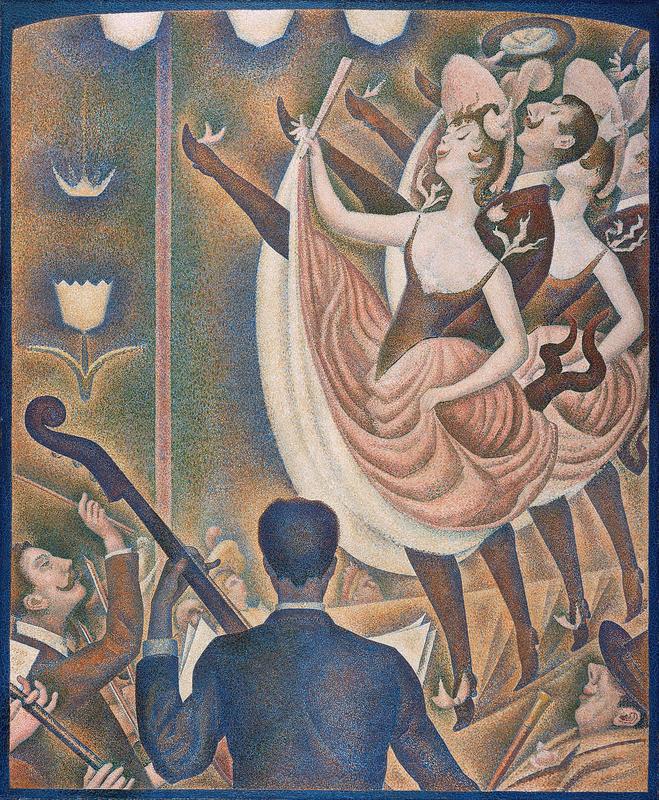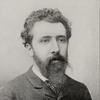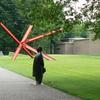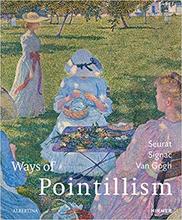More about Le Chahut
- All
- Info
- Shop

Contributor
The year that he produced Le Chahut, Georges Seurat also hosted a friend, Vincent van Gogh, who was not a fan of the painting.
This was another moment when Seurat's meticulously intellectual approach to art influenced critics: if painting were hunting, Seurat approached each animal with cold, scientific precision, reading books about science and math, measuring each angle and weighing the physics of each possible weapon and strategy, while van Gogh would use a little color theory, a couple of Seurat's techniques, journal about it, then run at the animal headfirst to attack with only his hands.
Seurat's portrayal of the raunchy nightlife of a local café and music establishment was the result of many years of studying what he considered to be the science—the psychological and mathematical ideas—inherent in the process of art consumption. Nowadays, the notion that there is a scientific or mathematical way to create the "ideal artistic image" is no longer en vogue, but many viewers of Seurat's work appreciated his application of scientific theories, particularly those of Charles Henry, just as we might appreciate such research in an architect or city planner today. As a result of Seurat's cerebral approach, Le Chahut was "too mechanical" for van Gogh, and the critic and former Le Chahut owner Gustave Kahn found the contrast between the unusual-looking possible voyeur in the lower right of the image with the "beautiful dancer" to be "disgraceful." Hey, you can't please everybody.
According to Charles Henry, lines going upward make people happy, so Seurat made sure to put lots of upward-pointing lines in Le Chahut. The upright bass falls in line with the legs of the dancers and three peoples' noses, which look like they are suspended from the ceiling with fishing line. As in this painting, "calculatedly repetitive effects were one of the techniques of Symbolist writing," a movement which Seurat greatly influenced. The freewheeling vibe of the nightlife scene does, though, seem to contrast with Seurat's highly intellectual, research-driven approach. Compare this work, for example, to Henri de Toulouse-Lautrec's At the Moulin Rouge. Toulouse-Lautrec's loose brushstrokes and expressive lines seem to capture the movement and liveliness of a nightclub in a way Seurat's work does not.
Another thing that both upset and excited the critics is the way that Seurat made this nightlife scene into a spectacle, revealing the end of the chahut, or Can-can dance, in a way that mimicked a more formal ceremony. Art historian Michelle Foa relates to us that the Symbolist poet and friend of Seurat Jean Ajalbert, wrote of
The leg that she throws high up
straight toward the frenetic audience
piercing everyone's eyes
with her sealed undergarment...
Another Seurat pal, Jules Christophe, noted that the painter confers upon these Parisian women, despite, or even because of their working-class social position, "the nearly sacred character of priestesses accomplishing rites." To which we can only reply..."Holy underwear, Batman!"
Sources
- Bouleau, Charles. The Painter's Secret Geometry: A Study of Composition in Art. Mineola, NY: Dover, 2014.
- Collier, Peter, and Robert Lethbridge. Artistic Relations: Literature and the Visual Arts in Nineteenth-century France. New Haven: Yale University Press, 1994.
- Düchting, Hajo. Seurat. Köln: Taschen, 2000.
- Eksteins, Modris. Solar Dance: Genius, Forgery and the Crisis of Truth in the Modern Age. Toronto: Knopf Canada, 2012.
- Foa, Michelle. Georges Seurat: The Art of Vision. New Haven: Yale University Press, 2015.
- Herbert, Robert L. Seurat: Drawings and Paintings. New Haven: Yale University Press, 2001.
- Thomson, Richard. Seurat. London: Phaidon Universe, 1985.
Featured Content
Here is what Wikipedia says about Le Chahut
Le Chahut (English: The Can-can) is a Neo-Impressionist painting by Georges Seurat, dated 1889–90. It was first exhibited at the 1890 Salon de la Société des Artistes Indépendants (titled Chahut, cat. no. 726) in Paris. Chahut became a target of art critics, and was widely discussed among Symbolist critics.
The painting—representing a can-can at the Moulin Rouge—influenced the Fauves, Cubists, Futurists and Orphists.
Formerly in the collection of French Symbolist poet and art critic Gustave Kahn, Chahut is located at the Kröller-Müller Museum in Otterlo, Netherlands.
Check out the full Wikipedia article about Le Chahut













